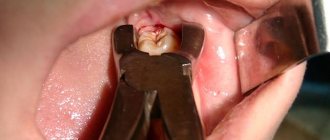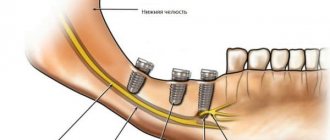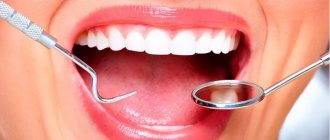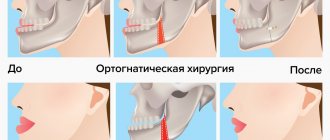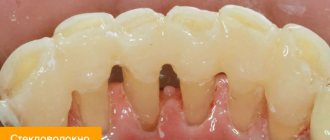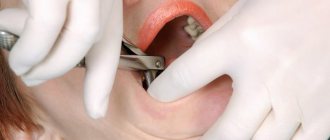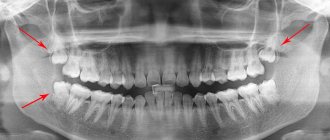04.11.2019
Many patients try to put off visiting the dentist until the last minute because of a panicky fear of the doctor’s chair. They endure painful sensations, rinse their mouths with various decoctions and wonder whether it is painful to remove a tooth - after all, the feeling of possible pain during the procedure can scare off even the most fearless patient. Thus, the situation can be delayed to such an extent that teeth have to be removed urgently.
In fact, now in dentistry all conditions are created not only to ensure that the removal goes smoothly, but also to ensure that the patient feels as comfortable as possible. For those who are still afraid of the extraction procedure, it will be very useful to read this article; further, the types of modern anesthetics will be described in detail, how extraction is carried out, and in which cases it is better not to delay a visit to the dentist.
Indications and contraindications for removal
The removal operation leads to complete loss of the crown and deformation of the jaw, so dentists recommend installing a prosthesis to avoid complications and cosmetic defects.
The decision on removal is made by the dentist after examination and x-ray examination on an individual basis. The following conditions are indications for urgent surgery:
- acute inflammatory process, tissue suppuration and swelling, spread of infection to soft tissues and bones;
- abscess, cyst suppuration;
- severe swelling and the impossibility of therapeutic treatment;
- tooth decay and impossibility of restoration.
Extirpation is prescribed routinely for the following pathologies:
- Chronic periodontitis. Advanced sluggish inflammation of connective tissue.
- Advanced periodontitis. Inflammation of the gums causes teeth to become loose and fall out.
- Malocclusion associated with abnormal positioning of incisors and molars. In this case, the operation is performed to restore the correct structure of the dentition.
- Fracture of the jaw along with the tooth.
- With the development of neoplasms in the jaw area, especially malignant ones.
You cannot perform surgery during an exacerbation of respiratory diseases or stomatitis, since the postoperative socket is highly likely to become infected and fester.
A contraindication to extirpation is the serious condition of the patient - the development of renal failure, cancer, acute circulatory and cardiac disorders, etc. In this case, it is recommended to stop the underlying disease, and only then proceed with dental surgery.
The relative indication for surgery is the first trimester of pregnancy, since anesthesia cannot be used. Surgery is not recommended for the 9th month of gestation, as well as for women during menstruation, since the woman’s body undergoes a heavy load during this period.
Experts' opinion
Question: Is it possible to rinse your mouth after tooth extraction? If yes, then with what?
Answer : During the first 24 hours after a molar tooth has been removed, doctors at the Optimal Choice clinics do not recommend rinsing your mouth at all. Active rinsing of the mouth, even if its goal is to cleanse food debris, can lead to a number of negative consequences. The main danger is the destruction and washing out of the formed blood clot in the socket, which interferes with rapid healing. This can also lead to the development of alveolitis. In the first few days, instead of rinsing, it is better to use baths with a decoction of medicinal plants (sage, chamomile, oak bark), a weak solution of salt or baking soda (or a mixture of them in equal proportions), furatsilin, miramistin, chlorhexidine, if prescribed by a doctor.
Question: After tooth extraction, the gums hurt and swelling is noticeable. What to do?
Answer: Slight tissue swelling and pain are very often consequences of the removal of molars. For relatively tolerable pain, it is recommended to take analgesics prescribed by your doctor. If the pain is severe, then you urgently need to visit the dentist again for a check. A cold compress applied to the cheek on the side of the extracted tooth for 15-20 minutes will help relieve swelling.
Is it painful to remove without pain relief?
Treatment without anesthesia is carried out quite often at the request of the patient. Treatment of shallow caries and extraction of baby teeth are almost painless. In such cases, anesthesia may not be used, or only a local anesthetic may be used.
Removal is definitely a painful procedure. How severe the pain will be depends on the condition of the crown and root, and its location. Very excruciating pain awaits a patient who is indicated for the removal of a wisdom tooth and entire, firmly seated molars.
Modern dentistry allows the use of anesthesia even in cases of intolerance to certain drugs. It is recommended to tell the doctor which medications cause negative reactions, and the dentist will select a safe remedy.
Stages of the depulpation process
- X-ray – necessary to assess the condition of the pulp, the number, length and branching of the canals to be filled.
- Anesthesia - local or complete anesthesia completely covers the issue of pain when removing a nerve (it doesn’t hurt!). At the same time, general anesthesia is used relatively rarely - when treating children, with true dental phobia, etc.
- Installation of a rubber dam - a latex film for insulating a tooth. A modern solution to improve the dentist’s working conditions and protect against the possible spread of microorganisms through saliva.
- The actual removal of the nerve is the excision of tissues affected by caries, opening the pulp chamber and extracting the nerve with a special instrument (pulpoextractor). In modern practice, this is a careful cutting of the pulp without affecting sensitive areas.
- Installation of a temporary filling (for a period of 1-2 weeks).
- Control x-ray.
If the x-ray and the condition of the tooth are satisfactory, after the control period a permanent filling is installed.
Tooth extraction with anesthesia injection
Dentists recommend carrying out the procedure with an injection of anesthesia, then the question is, does it hurt?
remove the tooth, it will fall off on its own. The drug reduces the conductivity of nerve endings, and pain impulses are temporarily not transmitted, the patient does not feel anything. The effectiveness of anesthesia depends on the drug. If a weak remedy is used, the patient feels mild pain.
The anesthesia lasts for a limited amount of time. The drug is gradually absorbed and eliminated from the body, and the sensitivity of the nerve endings is completely restored.
Anesthesia injections are performed differently in the upper and lower jaws due to the difference in structure. Less medication is required to treat the upper jaw because it has a porous structure. The medicine easily penetrates the tissue and acts quickly. When treating the lower jaw, it is necessary to inject the drug deeply. There are strong muscles and tight ligaments that interfere with the distribution of anesthesia.
Anesthesia methods
There are three methods of anesthesia:
- local using a spray;
- local injection into the gum;
- general anesthesia or anesthesia.
Local is used if the patient can remain motionless during manipulation. General anesthesia is indicated for people with severe mental illness, children, and sometimes adults who have a strong fear of the dentist.
Most patients are recommended to have local anesthesia injected into the gums around the affected area. If the patient is afraid of surgery, it is recommended that he take a sedative first. It is important to note that alcohol is contraindicated before removal.
Local anesthesia with a spray is carried out in cases where the tooth is loose, or for therapeutic purposes. Dental spray is often used to remove baby teeth in young children.
How does deletion work?
Removal surgery can be simple or complex. The doctor grabs the crown with forceps and swings it from side to side, spinning it around its axis to free it from ligaments and bone tissue. As a result, the surgeon removes the crown along with the root and places a gauze tampon in the hole to stop the bleeding.
If the crown has collapsed almost completely and there is no way to grab it with forceps and remove it along with the root, the operation is considered difficult. If the root is not affected, it can be left and a prosthesis installed on top. The damaged root is removed by cutting the gum. This operation is more traumatic and painful for the patient.
After surgery, it is recommended to stop drinking and eating for 2-3 hours, and then not chew on the injured side for several days. A blood clot forms in the hole, which protects the wound from infection, so you should not touch the gum with your tongue and try to rinse out the clot.
After the procedure, the gums hurt for another 1-3 days, depending on the degree of injury. Painkillers are prescribed to relieve pain. If the unpleasant sensations do not go away within 2-3 days, but only intensify, you should urgently consult a doctor.
Possible complications
If the procedure for removing a molar tooth was carried out by a doctor without proper experience, sanitary and hygienic requirements were violated, or the patient violated medical recommendations, then there is a possibility of complications:
- heavy bleeding that cannot be stopped for a long time;
- inflammatory process in the socket caused by infection;
- jaw movements become limited due to problems with the masticatory muscles;
- the alveolus is exposed;
- sharp edges of the hole are formed;
- limited osteomyelitis is diagnosed in the socket from the extracted tooth.
Symptoms of developing pathologies can be severe pain, unpleasant odor from the mouth, purulent discharge from the socket, the appearance of white plaque on the alveoli and the onset of bleeding. In these cases, you should immediately contact your dentist.
Molar tooth extraction
It is recommended to begin removing molars or molars after examining an x-ray, since the doctor needs to assess the location of the roots. A blind operation is fraught with complications.
If the molar has no abnormalities, it is removed with forceps. For maxillary molars, bayonet forceps are used. To remove teeth from the lower jaw, forceps with spikes are used that reach under the gum.
If the molar has a structural anomaly, for example, the root is located deeper than usual or the presence of bone tissue in the wrong place, then the situation becomes more complicated. A complex operation is performed with dissection of the gums or jaw tissue. If you try to remove such a molar in the usual way, nothing will work. Part of the tooth root may remain inside, increasing the risk of infection.
What is the dental nerve called?
In dentistry, the dental nerve, or pulp, is a complex structure - an interweaving of nerves and vessels located inside the root and crown of the tooth and responding to external stimuli.
Depulpation allows you to save the damaged tooth, but has negative consequences:
- Since the pulp acts as a barrier to infections, removing the nerve deprives the tooth of the necessary level of blood supply and mineralization, which shortens its “life.”
- A tooth deprived of a nerve loses sensitivity, the enamel becomes more fragile and faded, and the strength of the tooth decreases.
Wisdom tooth removal
Removing an upper wisdom tooth is no different from a similar operation on a regular molar and is carried out in the following order:
- anesthesia is performed;
- the doctor separates the tooth from the gum;
- the doctor grabs the tooth with forceps;
- shaking it from side to side, removes it.
The lower ones have tortuous roots; they are difficult to remove; the crown will need to be divided into parts. Sometimes wisdom teeth do not grow in completely; they are called impacted. Often this situation is accompanied by inflammation and suppuration of the gums, the patient complains of pain and the doctor decides to remove it. The impacted tooth is removed after making an incision in the gum, freeing the crown.
Is it painful to remove the root?
If the patient does not treat caries for a long time, the crown will completely crumble, but the root will remain inside the gum. This condition is fraught with the development of inflammation and suppuration, so it is recommended to cure the root and install a prosthesis, or remove the root if it cannot be treated.
Removing the root does not hurt if anesthesia is used. But after the operation, when the effect of the drug wears off, aching pain will appear. Its severity depends on the degree of injury to the gums. Unpleasant sensations occur 3 days after surgery.
General anesthesia.
Removal or treatment of teeth in a dream is prescribed for certain indications. The appointment is carried out under the supervision of an anesthesiologist with the mandatory use of monitoring equipment.
Dolotova Marina
“Is it painful to remove a baby tooth for a child under sedation - if it doesn’t wobble? Absolutely not. Usually during the appointment, the children watch cartoons while I carefully remove the tooth. And before that, we play superheroes with them and be sure to try on a real mask - a prototype of the Iron Man helmet!”
Tooth extraction during pregnancy
Dentists recommend checking the teeth of a woman who is planning a pregnancy so that treatment can be carried out in advance. If the patient neglects the recommendation and is faced with the need for removal, the procedure is performed in the second trimester. Starting from the 12th week of pregnancy, you can use some anesthetics, but there is still a risk of complications.
Surgery is stressful for the body, especially for women during gestation. The procedure can lead to premature birth, cause high blood pressure, dizziness and fainting. Therefore, dentists recommend avoiding removal in pregnant women and, if possible, carrying out therapeutic treatment.
Sources
- Operative maxillofacial surgery and dentistry. Ed. V.A. Kozlova, I.I. Kagan. Year 2021.
- Delete operation. Tutorial. Author Bazikyan E.A. and others. Dentistry. Chapter 4. Afanasyev V.V. [and etc.]; Ed. V. V. Afanasyeva. Year 2018
- Dentistry. Chapter 4. Afanasyev V.V. [and etc.]; Ed. V. V. Afanasyeva. Year 2018
- Propaedeutic dentistry. Edited by E.A. Bazikyan, chapter 12.
- Biomechanics of removal surgery. St. Petersburg State Medical University named after I. P. Pavlova, Dept. surgical dentistry, Dept. medical and biological physics; [comp. Lisenkov V.V. et al.]
Attention!
This article is posted for informational purposes only and under no circumstances constitutes scientific material or medical advice and should not serve as a substitute for an in-person consultation with a professional physician.
For diagnostics, diagnosis and treatment, contact qualified doctors! Number of reads: 5324 Date of publication: 03/11/2019
Dentists - search service and appointment with dentists in Moscow
